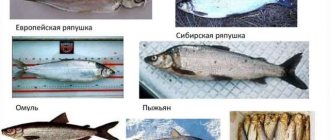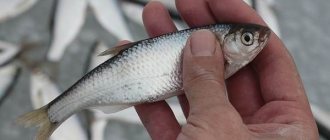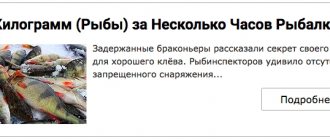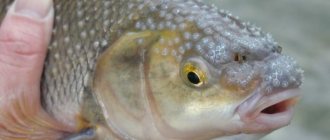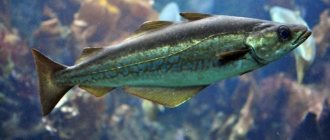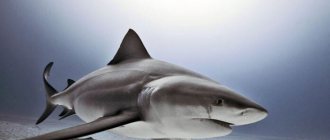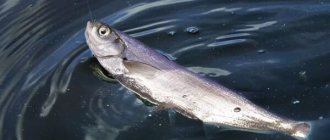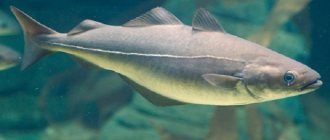What does “migratory fish” mean?
The term "migratory fish" applies to those species whose life cycle takes place partly in the sea and sometimes in rivers that flow into that sea. As for the species in question, omul spawns in rivers and feeds in the coastal zone of the Arctic Ocean. This type of migratory fish is called anadromous. If a fish goes out to sea from the river to spawn, it is called catadromous.
Appearance
The omul fish (photo posted in the article) has an almost regular, elongated body shape. This means that the middle axis passes through the torso and the middle of the head. The mouth of the fish is terminal and small in size. The upper and lower jaws are equal in length. Medium size eyes.
The sides are a beautiful silver color and the back has a brownish-green tint. Sometimes a thin black stripe is visible on the sides. On the belly the color is much lighter. The Arctic omul is covered with small, dense scales. The fins and tail, as well as the sides, are silver in color. A fatty, leathery unpaired fin located behind the dorsal fin is noticeable on the back. It consists of adipose tissue without fin rays. During the spawning period, males develop epithelial growths, which makes it possible to visually distinguish between males and females.
Varieties
When describing what Arctic omul is like, they usually mean two types:
- Coregonus autumnalis.
- Coregonus autumnalis migratorius.
The second species is called the Baikal omul. This is an endemic fish that lives in freshwater Baikal. From the lake where the omul lives, it comes out into the rivers to spawn. This happens in the autumn period, from September to November.
The Baikal omul is somewhat larger, its average weight reaches more than 1 kg. The largest fish caught by fishermen weighed 7 kg. The average length of the omul is 60-70 cm. A number of hypotheses have been voiced about how this species could have leaked from the ocean into Baikal. Traditionally, this fish was identified as a subspecies of Arctic omul (Coregonus autumnalis migratorius), but later the results of genetic tests identified it as an independent species - Coregonus migratorius.
Meat composition
The calorie content of omul meat ranges from 65 kcal to 92 kcal per 100 g of fish. In addition to fats, proteins and water, omul meat contains vitamin PP, B vitamins, microelements: chromium, zinc, nickel, molybdenum, fluorine and the macroelement chlorine.
Omul is one of the most nutritionally valuable commercial fish. About 20% of the total body weight of omul is fat, this is especially true for the marine subspecies of omul and, despite the fact that fatty foods are not held in high esteem today, this does not apply to fatty omul meat. Since the meat of this fish has high digestibility and nutritional value, the body absorbs omul meat in 1-1.5 hours by almost 95%, while it takes more than 5 hours to digest animal meat by 85%.
Fat in omul meat is found in the abdominal cavity, in the subcutaneous layer and in the liver, and it is evenly distributed between the muscles and is even found in the fins.
Omul, especially lightly salted, is rich in essential fatty acids, which reduce blood viscosity, improving the functioning of the heart muscle and nervous system. Omul meat contains more B vitamins than other fish species. These vitamins are very important for the human reproductive and nervous system.
In omul, the mass fraction of bones does not exceed 7%, and this makes it possible to prepare high-quality canned food from it and use it for dietary nutrition. Lightly salted omul is considered the most healthy and tasty; smoked omul meat is valued for its delicate texture and low salt content. Residents of the places where omul lives dry it, fry it, make pies from this fish and simply bake it without spices with a little salt.
Scientific hypotheses
Since the final bullet in defining the Baikal omul has not yet been set, it would not be superfluous to describe how scientists are trying to explain its appearance in the freshwater lake. The most probable are 2 hypotheses:
- Omul on Baikal is a local form, that is, it is an endemic fish, the ancestors of which lived in the waters of Baikal millions of years ago. In support of this hypothesis, not only scientific facts are cited, but also folklore sources (legends, traditions, songs). And in contrast to the hypothesis, the opinion is put forward that endemics cannot be found in other parts of the planet, and salmon, similar to the Baikal omul, live in many places. In addition, the Arctic omul has very few differences from the Baikal one.
- The Baikal omul swam into the lake during the interglacial period from the Arctic Ocean along the Lena River. In defense of this hypothesis, evidence of similarities between the two species is given.
However, if we take into account genetic research, the Baikal omul is somewhat closer to whitefish. This requires putting forward new theories about the origin of the species.
How to cook better
Omul meat has a very pleasant taste, high juiciness and tenderness, a bit like grayling. Fish is prepared in a variety of ways, namely:
- subjected to cold and hot smoking;
- salt;
- fried;
- baked in the oven;
- boil;
- dried.
The most delicious dishes are made from fresh omul. But frozen fish also retains all its nutritional properties when properly stored.
Attention! Arctic sea omul can be eaten raw. Freshwater fish requires high-temperature processing.
Omul with mushrooms
Omul baked in the oven with mushrooms turns out to be very tasty and aromatic. The recipe requires:
- omul - 3 pcs.;
- tomatoes - 2 pcs.;
- champignons - 100 g;
- hard cheese - 80 g;
- onions - 1 pc.;
- lemon juice - 2 tbsp. l.;
- vegetable oil - 3 tbsp. l.;
- salt - to taste;
- pepper - to taste.
The cooking algorithm looks like this:
- The fish is gutted and scaled, the head is cut off, and then the carcass is rubbed with salt and pepper and sprinkled with lemon juice.
- Leave the workpiece to marinate for 15 minutes.
- Scald the tomato with boiling water, remove the skin and cut into rings.
- Chop the onion and fry in a frying pan until golden brown.
- Mushrooms are chopped into thin slices.
- Place all prepared ingredients in baking foil.
- Sprinkle the dish with cheese shavings and place in the oven at 190°C for 45 minutes.
When a golden crust appears on the surface of the fish, it can be removed and served.
If desired, the omul can be rubbed with your favorite seasonings before placing in the oven.
Omul cutlets
You can use tender fish to prepare delicious dietary cutlets. Ingredients you will need:
- omul - 2 pcs.;
- eggs - 2 pcs.;
- onions - 2 pcs.;
- flour - 1/2 cup;
- salt - to taste;
- pepper - to taste;
- stale bread - 3 pieces.
We recommend reading: Deer meat: composition, benefits and harm to the human body
The recipe for making cutlets looks like this:
- The fish is cleaned, gutted and all the bones are removed from the fillet.
- Grind the meat in a meat grinder along with onions and bread crumbs.
- The resulting minced meat is sprinkled with salt and pepper and kneaded properly.
- Make small cutlets from the workpiece and roll in flour.
- Fry in oil in a frying pan for five minutes on each side.
- Cover with a lid and continue heat treatment for another ten minutes.
Cutlets are usually served with boiled rice or mashed potatoes; you can complement the dish with sour cream sauce and lettuce.
Omul is an oily fish, so vegetable oil is added in small quantities when preparing cutlets
Ban on fishing for omul in Lake Baikal
Today, the Baikal omul is under threat. It is becoming less and less. This has led to the question of a complete ban on fishing this species for 3 years, starting in 2017. Such a measure will help preserve the species and restore it as a natural resource. Poachers who illegally catch tons of fish every year will be more strictly prosecuted.
Buyers will not suffer in this case, since in markets and store shelves it can be replaced with Arctic omul caught in the ocean (although these species differ in taste).
It is worth noting that similar measures were already taken in 1969, when the number of Baikal omul fell catastrophically. The ban was in effect until 1979, after which it was concluded that the numbers had recovered.
Contraindications to the use of omul
Fatty fish, such as omul, is contraindicated if the body is hypersensitive to fish and fish products, as in this case it can cause an allergic reaction in the body. Fish oil is not recommended if there is a large amount of vitamin D and calcium in the blood. This fish is also contraindicated for stones in the biliary and urinary tracts. You should not eat omul if your thyroid function is elevated.
The important commercial importance of omul is difficult to overestimate. It is possible to use omul as an object for reproduction in lakes and reservoirs. And, despite the fact that restrictions have been introduced on catching, for example, Baikal omul, its number in the lake has decreased in recent years and is falling catastrophically, which means that the omul population needs care and protection.
Sources: inflora.ru , tutryba.ru
Similar articles:
Burbot
Burbot, or common burbot (Yakut. Syalyhar, Syan, aan (Kolyma)) is the only exclusively freshwater fish of the order Gadiformes. It has commercial value. It is caught in Siberian rivers. They cook fish soup from it and bake pies. The liver of burbot is large and very fatty, and is a delicacy. Durable thick leather is used for crafts...
Asian smelt
Asian smelt, or American smelt (Yakut. Timir atah). Smelt is a migratory fish and has freshwater lake subspecies. Widespread and highly populated...
Chir
Chir, or shokur (Yakut. Chyir, mun, ur, Young chir - Khara Atah (Yana)) is a freshwater fish from the whitefish family….
Sterlet
Sterlet (lat. Acipenser ruthenus) is a fish of the sturgeon family. Body length reaches 125 cm, weight - 16 kg. Sterlet belongs to the sturgeon family, and we can say that it is perhaps the most remarkable fish of all sturgeon species. Even despite its relatively small size...
Siberian spined loach
Siberian spined loach (lat. Сobitis melanoleuca) is a fish of the loach family….
What do omuls eat?
The places where omul is found are cool, oxygen-rich, with clean water. The species lives in schools, feeding on large crustaceans, gobies, and young fish. The fish is considered an omnivore. If there is no larger prey, they easily switch to plankton. During the feeding period, the species feeds very intensively in order to restore vitality. For this purpose it selects coastal, shallow bay areas. The water here is not too salty, rather brackish.
The Baikal omul feeds on zooplankton, amphipods (a type of crustacean), and young animals of other species.
Reproduction
In the Arctic omul, sexual maturity occurs at 4-8 years. By this time, its body is at least 35 cm. To spawn, the species rises into rivers, sometimes traveling more than 1,000 km. During the spawning transition, the fish does not eat, as a result of which it loses a lot of weight. Females spawn all the eggs in one go. The omul caviar is of a bottom type. It is not sticky and is quite large relative to the size of the fish. The eggs are from 1.5 to 2.5 mm in diameter. The laid eggs do not stay at the spawning site; they roll down to the lower reaches of the rivers. Observations on the river Pechora showed that the spawning stock included individuals from 4 to 13 years old. During her life, the female spawns 2-3 times. Having spawned, the fish rolls downstream into the sea.
Puberty of the Baikal omul occurs at the age of 5 years. By this time, its length is at least 28 cm. The spawning stock contains individuals from 4 to 9 years old. The Baikal omul enters rivers to breed in two schools. The first occurs in early autumn (September), the second at a temperature of 4° C (October-November). For spawning, an area with rocky and pebbly soil and a fast current is selected. After spawning, the omul goes downstream to Baikal.
Diet and spawning of omul
Favorite food is planktonic crustaceans, amphipods, larvae, eggs of other fish, whitefish and perciformes, especially gobies. In sea conditions, the omul eats a lot of gammarus, mysids, large crustaceans, small cod and sculpin species: smelt, capelin, navaga, cod, and Arctic sea slingshot.
The feeding of omul stops in August-September. Sexually mature fish gather in large schools and come from the sea to the deltas of Siberian rivers to spawn. Finding a suitable spawning site can take more than a month. During this time, the fish manages to rise upstream by 1.0-1.5 thousand kilometers, while remaining cautious and preferring to stay at the maximum distance from the shore. The Baikal subspecies does not have such problems and mainly moves short distances deep into the Selenga, Angara, Kichera, and Barguzina.
Autumn spawning of omul is associated with a long incubation period of larvae (190-220 days). The main time for laying eggs (up to 65 thousand) falls at the end of September-October, when the water temperature drops to +3-4C. For this process, flowing places with a depth of two meters and sand and pebble soil are selected. The masonry is not attached to the bottom substrate, which allows the current to freely carry it to secluded places, where it slowly develops at a water temperature of +0.5-1.5C.
After the omul has completed spawning, its appetite returns, and it begins to gradually migrate from the spawning grounds to its usual feeding areas. At the same time, nothing threatens the health of the fish, and unlike many migratory salmon (sockeye salmon, chum salmon, pink salmon), it does not die after spawning.
To learn more:
Fishing for burbot in winter
